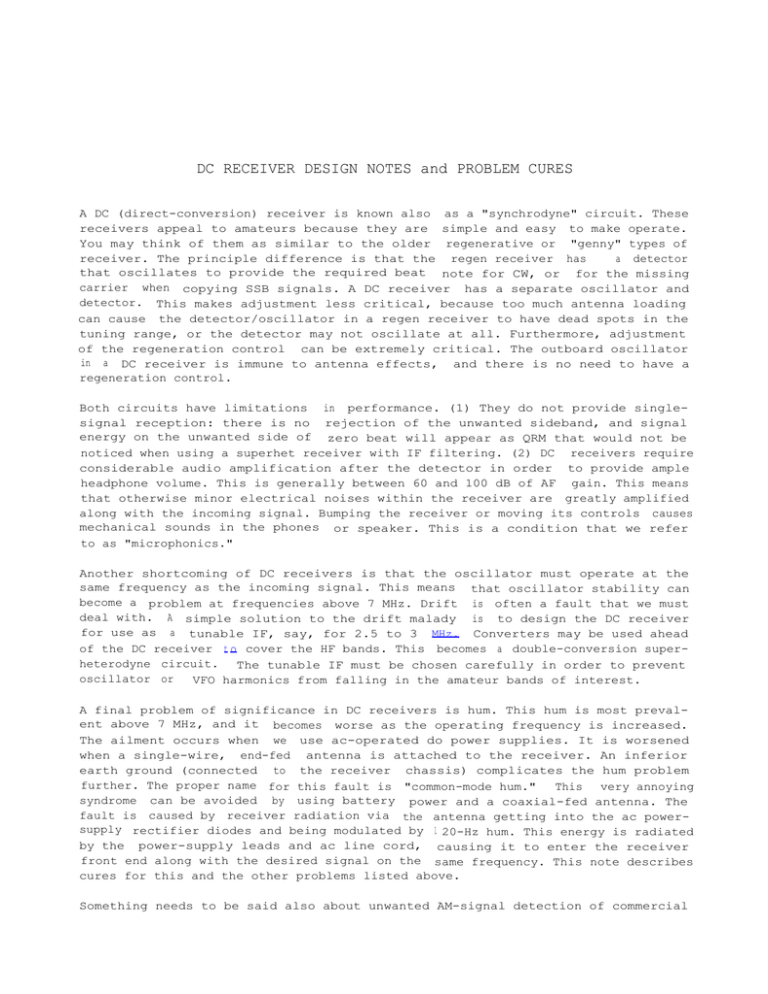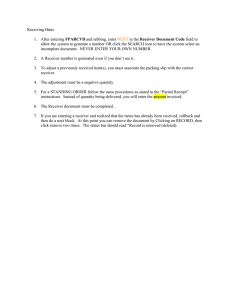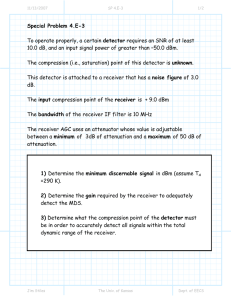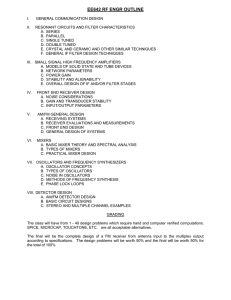DC RECEIVER DESIGN NOTES and PROBLEM CURES
advertisement

DC RECEIVER DESIGN NOTES and PROBLEM CURES A DC (direct-conversion) receiver is known also as a "synchrodyne" circuit. These receivers appeal to amateurs because they are simple and easy to make operate. You may think of them as similar to the older regenerative or "genny" types of receiver. The principle difference is that the regen receiver has a detector that oscillates to provide the required beat note for CW, or for the missing carrier when copying SSB signals. A DC receiver has a separate oscillator and detector. This makes adjustment less critical, because too much antenna loading can cause the detector/oscillator in a regen receiver to have dead spots in the tuning range, or the detector may not oscillate at all. Furthermore, adjustment of the regeneration control can be extremely critical. The outboard oscillator in a DC receiver is immune to antenna effects, and there is no need to have a regeneration control. Both circuits have limitations in performance. (1) They do not provide singlesignal reception: there is no rejection of the unwanted sideband, and signal energy on the unwanted side of zero beat will appear as QRM that would not be noticed when using a superhet receiver with IF filtering. (2) DC receivers require considerable audio amplification after the detector in order to provide ample headphone volume. This is generally between 60 and 100 dB of AF gain. This means that otherwise minor electrical noises within the receiver are greatly amplified along with the incoming signal. Bumping the receiver or moving its controls causes mechanical sounds in the phones or speaker. This is a condition that we refer to as "microphonics." Another shortcoming of DC receivers is that the oscillator must operate at the same frequency as the incoming signal. This means that oscillator stability can become a problem at frequencies above 7 MHz. Drift is often a fault that we must deal with. A simple solution to the drift malady is to design the DC receiver for use as a tunable IF, say, for 2.5 to 3 MHz. Converters may be used ahead of the DC receiver t o cover the HF bands. This becomes a double-conversion superheterodyne circuit. The tunable IF must be chosen carefully in order to prevent oscillator or VFO harmonics from falling in the amateur bands of interest. A final problem of significance in DC receivers is hum. This hum is most prevalent above 7 MHz, and it becomes worse as the operating frequency is increased. The ailment occurs when we use ac-operated do power supplies. It is worsened when a single-wire, end-fed antenna is attached to the receiver. An inferior earth ground (connected to the receiver chassis) complicates the hum problem further. The proper name for this fault is "common-mode hum." This very annoying syndrome can be avoided by using battery power and a coaxial-fed antenna. The fault is caused by receiver radiation via the antenna getting into the ac powersupply rectifier diodes and being modulated by 1 20-Hz hum. This energy is radiated by the power-supply leads and ac line cord, causing it to enter the receiver front end along with the desired signal on the same frequency. This note describes cures for this and the other problems listed above. Something needs to be said also about unwanted AM-signal detection of commercial 2 DC Receivers short-wave broadcast stations. This ailment is all too common when we use a single element detector -- known as a product _detector. For example, a single dual-gate MOSFET (40673 or 3N211) as the detector. Since this is not a balanced detector it will respond nicely to AM signals. There can be times when these unwanted signals will blanket the band of interest, and they can be quite loud. The use of an attenuator at the receiver input can remove the AM signals, but it also weakens the strength of the desired signals. A better approach is to use a singly or doubly balanced detector, diode or active type. Fig. 1 shows circuits of each of these detectors. A FAIR BOTTOM VIEW Fig. 1 -- Practical examples of three DC receiver detectors. Circuits A and B provide conversion gain, whereas circuit C has a conversion loss. Circuit C requires more oscillator injection power than the circuits at A and B. C1 and L1 at A and B are tuned to the signal frequency. The diodering detector at Q 'requires an RF amplifier ahead of it for use above 4 MHz. The diodes at C are hot-carrier types or matched 1N914s. T1 and T2 are trifilar wound broadband transformers (12 trifilar turns of no. 28 enam. wire on an FT-37-43 toroid~ Although a center-tapped winding ( as shown) may be used, obtaining electrical balance is difficult with this type of transformer. The circuit at A of Fig. 1 offers no rejection of AM signals. Circuit B does offer some AM rejection, but can still be overwhelmed by strong AM signals. A CA3028A IC may be used as a singly balanced detector in place of Q1 and Q2 at B. Best 3 DC Receivers AM-signal rejection occurs with the detector of Fig. 1C. This doubly balanced detector has a conversion loss of approximately -8 dB, which requires additional post-detector audio gain, or the addition of aq RF amplifier ahead of the detector. An RF amplifier will improve the receiver noise figure when a diode-ring detector is used, particularly above 4 MHz. An IC balanced mixer may be used in order to achieve conversion gain. ICs such as the MC1496 may be used, or the circuit can contain four 40673s in a doubly balanced arrangement. The diodes in circuit C of Fig. 1 should be closely matched for forward resistance. This may be done with an ohmmeter prior to installation. Symmetrical layout is vital for ensuring a well balanced detector or mixer. The addition of a 1 0-15 dB RF amplifier can be beneficial ahead of any of the detectors found in Fig. 1. The additional front-end gain will aid the overall receiver noise f igure and it will increase the effective gain ahead of the audio amplifier section. This tends to minimize the effects of receiver microphonics, since the audio gain setting will be lower than without an RF amplifier. But, by adding a gain stage ahead of the detector we will lower the dynamic range of the detector ( it will overload more readily when strong signals are present). Blanketing from AM stations will also be more severe with circuits A and B in Fig. 1. No RF amplifier is needed at A and B for operation below 7 MHz, respective to improved noise figure. Simple RF amplifiers are detailed in ARRL's Solid State Design by W7ZOI and W1FB. Curing Common-Mode hum The WIFB QRP Notebook illustrates the necessary steps for treating the ac power supply to prevent common-mode hum. Essentially, each rectifier diode should be shunted with a 0.01-uF disc capacitor. The ac line (at the transformer primary) should be bypassed to ground with two more 0.01-uF discs. A decoupling choke is added to the plus and minus output leads (12 V do terminals). This choke consists winding ( two wires in parallel, wound at the same time) that has of a bifilar 1 5 turns of no. 24 enam. wire on an Amidon FT-82-43 toroid. Locate this choke inside the power supply, directly at the output terminals. You may also add this choke external to a power supply by placing it at the do terminal posts. The plus do lead passes through one winding and the negative lead passes through the other winding. This keeps oscillator energy in the DC receiver from entering the power supply via the do supply leads to the receiver. Wire of heavier gauge and a larger ferrite toroid will be needed for high-current do power supplies if the receiver draws in excess of 2 amperes. A quality earth ground should be connected to the power-supply case or chassis Improving DC-Receiver Selectivity Nothing can be done to sharpen the RF selectivity of a DC receiver, at least in the sense that. i t isdone with modern superhet receivers. In other words, you will never be able to achieve single-signal reception. But, the overall bandwidth of the receiver can be improved markedly if you add an LC or RC active audio filter. The ARRL handbook and Solid State Design have complete design information concerning RC active low-pass, high-pass and bandpass audio filters. Additional data i s provided for building an LC coil/capacitor passive filter. .. The audio filter should not immediately follow the detector, since this arrangement may degrade the overall noise figure. This is because most op amps used in active filters are fairly noisy, especially those that do not have FET inputs. The op-amp noise will establish the receiver noise figure if used in this manner. 4 DC Receivers Ideally, the audio filter *ould be situated as close to the detector as possible, ' rather than at the receiver output This is because an audio filter can be over driven by excessive audio, and this causes distortion. The best approach is to add a low noise audio preamplifier (such as a 2N3904 or MPF102) directly after the detector, then follow it with the audio filter. The low-noise preamp will then establish the overall noise figure. The audio-gain control should be added after the audio filter. TLO80 op amps are more quiet than are the generic 741 op amps. I recommend the TLO series. The active-filter selectivity is determined by the design Q and the number of stages (poles). Generally, a 3-pole active filter is sufficient for CW reception with a DC receiver. It should have a bandpass response. A low-pass audio filter is my choise for SSB reception. The cutoff frequency should be approximately 1800 Hz. Audio filters also help reception by reducing wide-band receiver noise. They also tend to lift the received signal above the atmospheric and manmade noise that arrives via the antenna. A center frequency of 600-700 Hz is best for most CW reception when designing an active bandpass filter. This provides a beat note that closely matches that of most commercial CW transmitters. This low-pass filter is suitable also for CW reception, but it will not yield a response that is as narrow as a CW bandpass filter designed for a 700-Hz peak. A Practical 40-Meter DC Receiver Fig. 2 shows the circuit of a DC receiver that is set up to avoid the of many DC receivers. common ills Fig. 2 -- Schematic diagram of a 40-meter DC receiver. Polarized capacitors are 16-V electrolytic or tantalum. Fixed-value capacitors not in parts list are 50-V disc ceramic. Resistors are 1/4-W carbon. C1 is a 100 pF mica trimmer. C2, C3 and C4 are NPO or polystyrene caps. C6 is a 100 pF NPO cap. C5 is a 30 - pF air variable driven by a vernier control. D1 is a 6.8-V, 400-mW Zener diode. L1 has 2 turns of no. 26 enam. wire over L2 winding. L2 (4.2 T50-2 toroid. uH) has 29 turns of no. 26 enam. wire on an L3 is 2.6 uH and has 25 turns of no. 24 enam. wire on an Amidon T50-6 toroid ( coat toroid winding with two applications of polystyrene Q Dope or other is an audio-taper, panel-mount carbon control. U1 low-loss cement) R1 is a Signetics IC and U2 is a National Semiconductor IC. 1 5 DC Receivers The heart of the receiver is the NE602 doubly balanced mixer IC. It is unique because it also contains the necessary components for a local oscillator. This chip was popularized by J.Dillon in February 1988 QST ("The Neophyte Receiver"). Another DC receiver that uses the '602 was described in Dec. 1988 Ham Radio by A. Kreuter. The main-tuning capacitor (C5) in Fig. 2 will provide coverage from 7.0 to 7.3 MHz. You may want to place a 25-pF trimmer in parallel with C5 to permit bringing the oscillator into the desired tuning range. Alternatively, a slug-tuned coil may be substituted at L3. NPO capacitors are best for use in the oscillator circuit if you desire good long-term frequency stability Polystyrene units may be substituted if you are willing to accept a slight tradeoff in stability. Silver-mica capacitors are not recommended. Dl drops the 12-V supply to b.8 V, which is for U1. An internal regula tor stabilizes the The Zener-diode dropping resistor and bypass audio decoupling network to prevent howls-and unwanted feedback from U2. Q1 is also decoup slightly below the maximum safe value oscillator operating voltage further. capacitors serve also as an effective motorboating that may result from led at audio from the +12-V line. Circuit points A and B to the right of Q1 indicate where an RC active audio filter should be added. Jumper these terminals if no filter is used. Q1 overrides the .1i noise generated within an op-amp audio filter, as discussed earlier. The three receiver stages provide an overall gain (antenna to phones) of roughly 75 dB. The gain of U2 may be increased (at risk of audio oscillations) by making the resistor at terminal 1 lower in ohmic value. it is important that the 470-uF bybass a t U2 pin 6 be located close to that pin. Should oscillation still be observed, add a 0.01-uF bypass from pin 3 to ground. If you desire to place the receiver i n STANDBY during transmit periods, simply break the do supply line to Q1 with a relay or switch. Tuneup is a simple matter. Adjust the oscillator portion of the circuit for the desired tuning range. You may listen to the oscillator signal with a communications receiver. Set it to cover 7.0 to 7.3 MHz Next, connect an antenna and find a weak signal at approximately 7150 kHz. Adjust C1 for peak signal response. DC Receiver Power Supply Earlier in This power hum. 1 20 VAC t his note we addressed the matter of common-mode hum with DC receivers supp.l y is designed to prevent or minimize this annoying form of receiver 1 2V Fig. 3 Schematic 'diagram of a hum-suppressed 12-V regulated power supply. See earlier text for Ll data. 11 has a 16- or l8-Vac secondary, 500 mA. U1 is a , 1 2-V, 3-terminal, 1-A regulator IC. 6 DC Receivers The rectifier diodes are 1 -A, 50-PRV types. T1 may be a 24-V transformer, but U1 will require a larger heat sink than when using a 1 6- or 18-V transformer. A small heat sink is needed for U1 in either case. The regulator should never be hot to the touch when the supply is operating. Select a heat sink that keeps i t cool or warm to the touch. Enclose - the supply in a metal box or cabinet for best immunity to common-mode hum. You may use, 10 size-C NiCd cells in series for portable operation. AA cells may also be used, but the battery reserve will be less than with size-C or D cells. Getting the Most from Your DC Receiver This application note outlines the simple steps needed to clean up most of the problems that afflict DC receivers. The cures may be applied to commercial QRP transceivers, such as the Heath HW-7 and HW-8 units, along with the older TenTec PM-series transceivers. Additional design data for QRP receivers is found in the WIFB QRP.Notebook and i n Solid State Design for the Radio Amateur. You are operating at disadvantage when QRPing, which demands top-notch receiver and transmitter performance The small expense and effort to make the changes mentioned in this file are worth your while. Changing existing capacitors in QRP VFOs and receiver oscillators t o NPO t ypes ( i f NPOs aren't t being used) , will help improve the oscillator stability. Also, if your receiver has a slug-tuned oscillator coil (hex or slotted slug), try melting a small drop of bee's wax or canning wax on the slug head after the coil has been adjusted. This prevents slug movement from temperature-related movement or vibration. A coating of Q Dope on the Coil windings aids stability by preventing movement of the coil turns. Avoid the use of double-sided PC board i n t he area of your oscillators. Capacitors are formed by the PC foils and ground plane, with the glass epoxy as the dielectric. These unwanted capacitors are very unstable! It is helpful also to place the tunable oscillator in its own shield compartment. This keeps stray RF energy out of the oscillator and reduces the effects of rapid changes in temperature (such as air currents, etc.).





